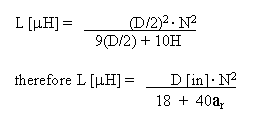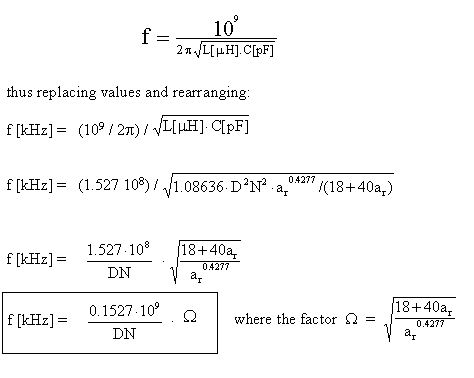
Considerations Regarding
The Kandoian & Sichak Formula
by Andrťs Esteban de la Plaza
The formula given by Kandoian & Sichak to calculate the quarter-wave resonant frequency f of a coil in kilohertz is:

where ar is the aspect ratio (H/D), N the number of turns and D the diameter if the coil in inches. According to K&S, agreement is within 10% of experimental values.
It may be shown that this formula may well be obtained considering only the distributed capacitance of the coil.
In his paper "TESLA COIL MYTHS" (Tesla Coils Builder Association -TCBA News, Volume 6, #3. 1987), Mr. William M. Colb deals with The Quarter-Wave Coil and explains the difference between electrical and physical length, and introduces de Kandoian & Sichak well known formula.
I will show in this paper that the K&S formula may be obtained considering only the distributed capacity of the coil (Medhurst's formula) combined with the usual tank formulas...
Then, for common aspect ratios found in Tesla coils ř 1 < ar < 7 , we have the following table of k:
|
aratio |
k |
|
7.0 |
1.01 |
|
6.0 |
0.92 |
|
5.0 |
0.81 |
|
4.5 |
0.77 |
|
4.0 |
0.72 |
|
3.5 |
0.67 |
|
3.0 |
0.61 |
|
2.5 |
0.56 |
|
2.0 |
0.50 |
|
1.5 |
0.47 |
|
1.0 |
0.46 |
A regression analysis of this table will give the following function for k as a function of ar:
k = 0.0965∑ ar + 0.3408
but a better approximation is given by:
On the other hand if we want a power form for the regression curve, instead of the linear one, then after some "number crunching" we will obtain:

Thus the Medhurst formula may be written as:
C [pF] = k∑ D[in]∑2.54
C [pF] = 0.4277∑ ar 0.4277∑ D[in]∑2.54
C [pF] = 1.08636∑ ar 0.4277∑ D[in]
Now letís continue with the Wheelerís formula for the inductance of the coil:

Now letís calculate the resonant frequency using Wheeler & Medhurst:

Now letís see if we can obtain a regression formula for W in the power form y =  . Thus, we plot W for different ar values, 0.5 < ar
< 10 , and obtain the following table:
. Thus, we plot W for different ar values, 0.5 < ar
< 10 , and obtain the following table:
|
ar |
W |
|
0.5 |
7.14936 |
|
1.0 |
7.61577 |
|
1.5 |
8.09823 |
|
2.0 |
8.53567 |
|
2.5 |
8.92980 |
|
3.0 |
9.28768 |
|
3.5 |
9.61567 |
|
4.0 |
9.91881 |
|
4.5 |
10.20101 |
|
5.0 |
10.46534 |
|
5.5 |
10.71425 |
|
6.0 |
10.94970 |
|
7.0 |
11.38633 |
|
8.0 |
11.78508 |
|
9.0 |
12.15293 |
|
10.0 |
12.49505 |
The best regression is a power curve given by
W = 7.65464∑ ar0.19815
Now we replace this formula of W in the f [kHz] one, thus:
f [Hz] = 0.1527∑ 7.65464∑ 109∑ ar0.19815 / DN
f [Hz] = 1.16886∑ 109∑ ar0.19815 / DN
or

Now letís compare this formula with the Kandoian & Sichak one:
řthereís only 0.523% difference...
řthereís only 0.925% difference...
Should we conclude that both formulas are the same? I believe the answer is YES!
The approach taken has some interesting points we should consider: